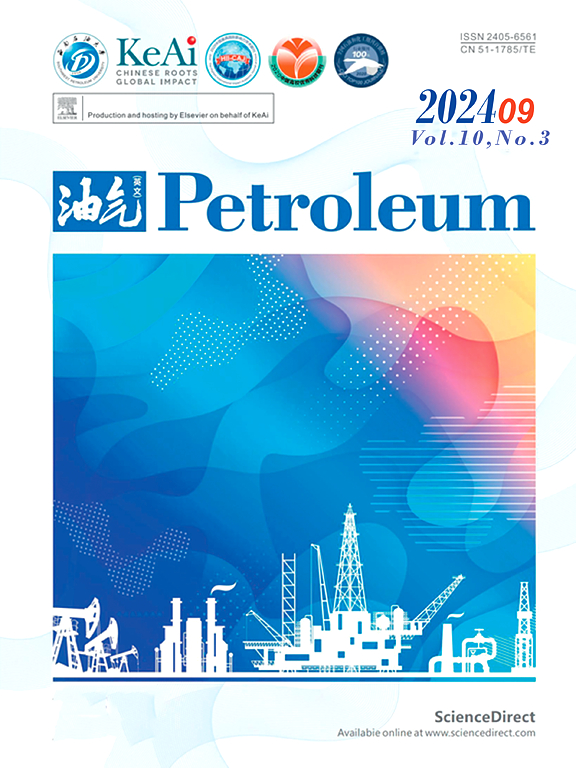注水如何诱发断层再活化和滑动:数值方法
IF 4.2
Q2 ENERGY & FUELS
引用次数: 0
摘要
在油田注水过程中,大量流体涌入储层,可能会破坏断层原有的应力平衡,导致断层运动。断层滑动除了会破坏井筒和套管的完整性外,还会导致地下油气的泄漏。为了阐明流体注入引起断层滑动的机理,量化断层滑动,建立了储层尺度的地质力学有限元模型。该模型结合了地质构造几何特征和不同深度岩石力学性质的信息。基于牵引-分离定律,利用黏性接触法描述断层泥的黏性力学强度及其损伤演化过程。因此,我们模拟并研究了注水后断层内聚强度和摩擦强度降低所导致的断层的再激活和滑动规律。研究结果表明,断层的相对稳定状态主要依赖于断层泥的胶结作用。随着侵入断裂带的流体体积增大,断层泥剪切胶结强度减小,导致断层完全活化。之后,断层开始滑动。断层恢复后的持续滑动受断平面摩擦强度的影响。随着断面摩擦系数的减小,断层的平均滑动距离增大。这项研究为流体注入对断层行为的影响提供了重要的见解,并可以指导油田注入作业的设计。本文章由计算机程序翻译,如有差异,请以英文原文为准。
On how water injection may induce fault reactivation and slippage: A numerical method
During the water injection process in oil fields, the original stress equilibrium of faults might be disrupted by the large influx of fluids into the reservoir, resulting in movements. Fault slip may lead to the leakage of underground oil and gas, in addition to impairing the integrity of wellbore and casing. To explicate the mechanism of fault slip caused by fluid injection, as well as quantify the fault slippage, A geomechanical finite element model on a reservoir scale is established. This model combines the information regarding the geological structural geometric characteristics and the mechanical properties of rocks at varying depths. Based on the TSL (traction-separation law), we utilize the cohesive contact method to depict the cohesive mechanical strength of the fault gouge and its damage evolution process. Consequently, we simulate and examine the reactivation and slip laws of the fault, which induced by the reduction of cohesive strength and frictional strength post water injection. The research results illustrate that the relatively stable state of the fault primarily relies on the cementation of fault gouge. As the volume of fluid invading the fault area increases, the shear cementation strength of fault gouge diminishes, resulting in the complete activation of the fault. Afterwards, the fault starts slipping. The continued slip post-reactivation of the fault is influenced by the frictional strength of the fault plane. As the friction coefficient of the fault plane drops, the average slip distance of the fault rises. This investigation offers important insights into the impact of fluid injection on fault behavior and can guide the design of injection operations in oil fields.
求助全文
通过发布文献求助,成功后即可免费获取论文全文。
去求助
来源期刊

Petroleum
Earth and Planetary Sciences-Geology
CiteScore
9.20
自引率
0.00%
发文量
76
审稿时长
124 days
期刊介绍:
Examples of appropriate topical areas that will be considered include the following: 1.comprehensive research on oil and gas reservoir (reservoir geology): -geological basis of oil and gas reservoirs -reservoir geochemistry -reservoir formation mechanism -reservoir identification methods and techniques 2.kinetics of oil and gas basins and analyses of potential oil and gas resources: -fine description factors of hydrocarbon accumulation -mechanism analysis on recovery and dynamic accumulation process -relationship between accumulation factors and the accumulation process -analysis of oil and gas potential resource 3.theories and methods for complex reservoir geophysical prospecting: -geophysical basis of deep geologic structures and background of hydrocarbon occurrence -geophysical prediction of deep and complex reservoirs -physical test analyses and numerical simulations of reservoir rocks -anisotropic medium seismic imaging theory and new technology for multiwave seismic exploration -o theories and methods for reservoir fluid geophysical identification and prediction 4.theories, methods, technology, and design for complex reservoir development: -reservoir percolation theory and application technology -field development theories and methods -theory and technology for enhancing recovery efficiency 5.working liquid for oil and gas wells and reservoir protection technology: -working chemicals and mechanics for oil and gas wells -reservoir protection technology 6.new techniques and technologies for oil and gas drilling and production: -under-balanced drilling/gas drilling -special-track well drilling -cementing and completion of oil and gas wells -engineering safety applications for oil and gas wells -new technology of fracture acidizing
 求助内容:
求助内容: 应助结果提醒方式:
应助结果提醒方式:


